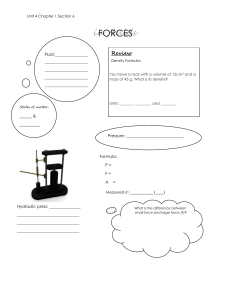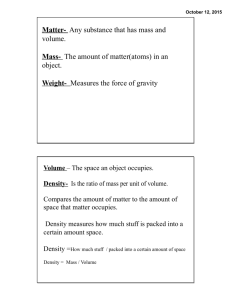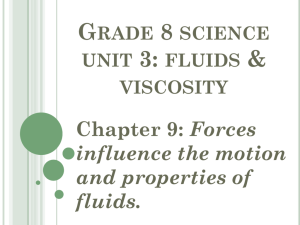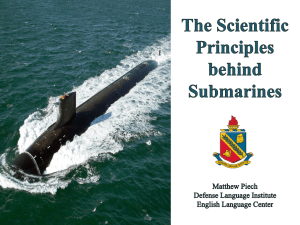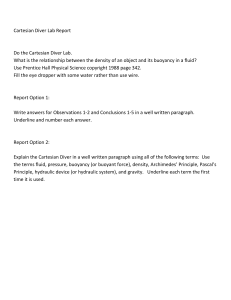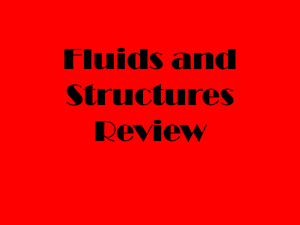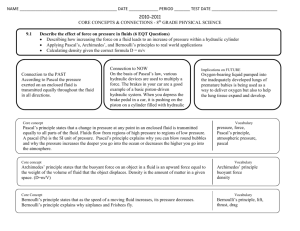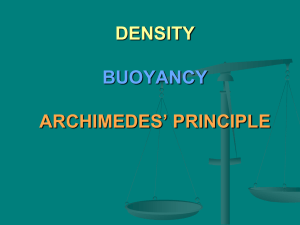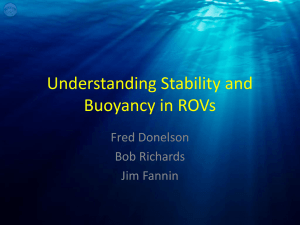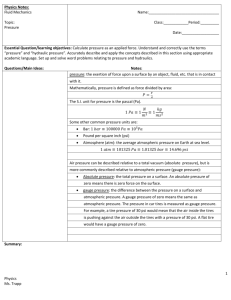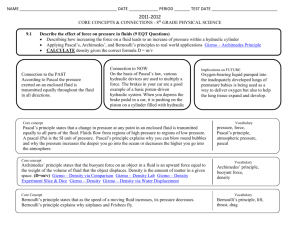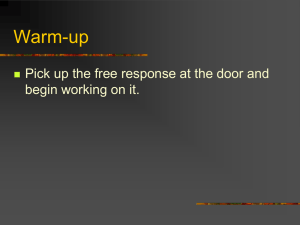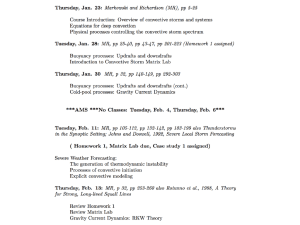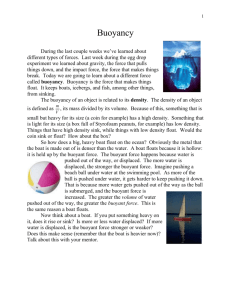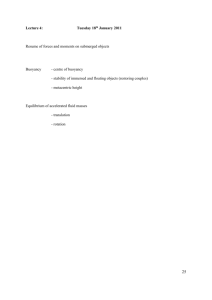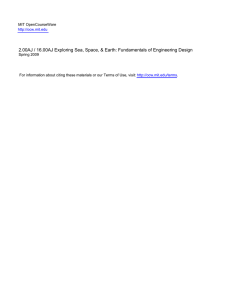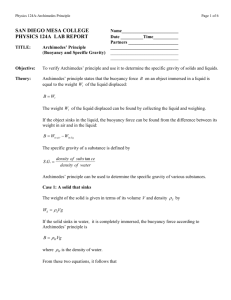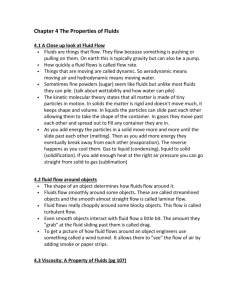Chapter Notes
advertisement
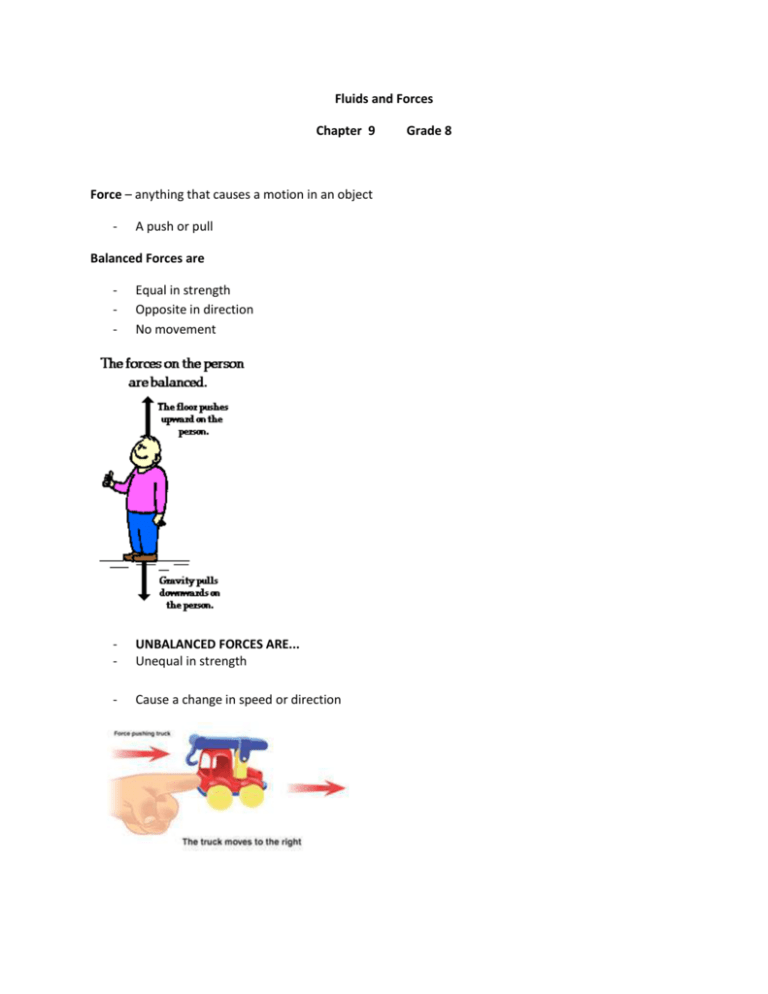
Fluids and Forces Chapter 9 Force – anything that causes a motion in an object - A push or pull Balanced Forces are - Equal in strength Opposite in direction No movement - UNBALANCED FORCES ARE... Unequal in strength - Cause a change in speed or direction Grade 8 MASS VS. WEIGHT Amount of particles that make up an object Stays the same anywhere in the universe A measure of the push or pull acting on an object. Measure of gravity pulling down on an object Change is dependant on the amount of gravity. So will be different on the earth and the moon Grams (g) / kilograms(kg) Newton (N) BUOYANCY The upward force working on an object submerged in or floating on fluids. An object that floats has neutral buoyancy. The force pulling the object down (gravity) and the buoyancy force pushing up are balanced. Archimedes’ Principle - The buoyancy force is equal to the weight of the water displaced by the object in the water. - The object weighs 7 lbs. In water it displaces 3 lbs of water which means the object now weighs 4 lbs in the water. - If you released the object it would sink because the weight is greater than the buoyancy force. We can use vectors (arrows) to show force. DENSITY & BUOYANCY If the density of the immersed object is greater than the density of the fluid, it will SINK. The gravitational force pulling down is greater than the buoyant force pushing up. If the overall average density can change then we can control floating and sinking. Air pockets added to an object can lower the overall density and make it float. A submarine floats when the water is replaced with air in the ballast tanks. WHICH WILL FLOAT? WHY? 1. Wooden boat vs. water logged stick The wooden boat floats because its overall density is less than the density of the water. The water logged stick sinks because the water has replaced air in the stick increasing the overall density making it sink. 2. Metal block vs. metal boat The air pockets, in the metal boat, decreases its average density making it less dense than the water. 3. A sealed empty water bottle vs. full water bottle Air is less dense than water so the average density of the empty water bottle is less, so it floats. The average density of the water in the water bottle is greater, so it sinks. AVERAGE DENSITY - The total mass of all substances that make up an object divided by the total volume. TECHNOLOGIES DEVELOPED Personal floatation devices, Submarines, Hot air Balloons PRESSURE - The force acting on a certain area of surface. The larger the force, the greater the pressure. The smaller the area, the greater the pressure. Which means it has more force CALCULATING PRESSURE The unit for pressure is the Pascal (Pa) You can determine pressure if you know the force and the area. Formula: Pressure (P) = Force (F) See triangles in text page 351 Area (A) Terms SI units of measurement Symbol Force newtons N Area Meters squared m2 Pressure Newtons/ meters squared Pascal N/m2 Pressure Pa SAMPLE PROBLEMS 1. An aquarium is filled with water that weighs 10 000N. If the base of the aquarium has an area of 1.6 m², what pressure does the water exert on its base? P= F A P= 10 000N 1.6m² P = 6250 Pa 2. If the atmospheric pressure is 101 200 Pa and you are holding your hand, the atmosphere is exerting a force on your hand. If the area of your palm is 0.006m², calculate the force on your hand. F=PxA F = 101 200 Pa x 0.006 m² F = 607 N 3. The weight of water in a glass is 4.9 N. If the water is exerting a pressure of 1700 Pa on the bottom of the glass, what is the area of the bottom of the glass? A= F P A= 4.9 N 1700 Pa A = 0.0029 m² Assignment: Complete the practice problems on pages 351-353 DETERMINE WHY... 1. A person wearing snowshoes can walk across a section of deep, soft snow without sinking (The surface area is increased while the force remains the same making the pressure on the snow less so you do not fall through) 2. The nozzle on a garden hose can be used to create a faster or slower flow of water. ( Decrease the surface that the water can come out of and you increase the pressure making the water appear to be faster) ATMOSPHERIC PRESSURE The pressure exerted by the layers of air surrounding the Earth that are held by the Earth’s gravity. (~ 160 km above the Earth) As you move up in the atmosphere there are less particles of gas to put pressure on you. As you move down in the water column there are more particles pushing down on you and therefore the pressure increases. PASCAL’SLAW Pressure applied to a enclosed fluid is transmitted with equal force throughout the entire container Pascal’s Law is the basis for hydraulic and pneumatic devices. HYDRAULICS The study of pressure in liquids. Hydraulic systems: devices that transmit applied force through a liquid to move something else. Hydraulic systems use liquids because they are incompressible (they cannot be squeezed into a smaller volume). The liquid must be enclosed in a tube or pipe. The pressure produced will exert in all directions equally. This pressure will cause motion at the other end of the hydraulic system PNEUMATIC SYSTEMS A gas is used to exert a force on the gas in an enclosed space. Compressors are necessary as gases can be compressed. They build up air pressure. PRESSURE & VOLUME Increasing pressure of a fluid will decrease volume by the same amount. **known as Boyle’s Law TEMPERATURE & VOLUME Increasing temperature will increase the volume of a fluid. TEMPERATURE& PRESSURE Increasing temperature of a fluid will increase the pressure. In order to build up the pressure on a pressure cooker you heat it up. Why does this symbol appear on aerosol cans? If the aerosol can cannot spray anymore then the pressure inside and outside the can are the same. However if you heat the can the pressure builds up inside and because the can is sealed it has no where to go and it explodes.
